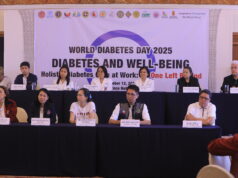By Dr. Jun R. Ruiz
MARCH IS Colorectal Cancer (CRC) Awareness Month. This is an important campaign as CRC is the fourth most common cancer among Filipinos following breast, lung, and liver cancers. This cancer is preventable, treatable, and beatable. CRC screening can save lives, but not that many people are being screened. As an advocate, I believe that now is the time to educate the general public and mobilize the health community to beat colorectal cancer.

Almost all of these cancers start as abnormal growths in the lining of the colon and rectum called polyps. These polyps grow slowly and it can take around 10 years for some polyps to develop into cancer — not all polyps progress to cancer. The removal of these polyps reduces the risk of developing cancer.
These polyps and occasionally early cancer do not cause complaints, like rectal bleeding, constipation, and abdominal pain that are experienced by patients in later stages of cancer.
RISK FACTORS FOR CRC
The common individual-specific factors that increase risk for cancer in the colon and rectum are:
1. Age greater than 50;
2. Personal history of colorectal cancer or advanced polyps; and
3. Family history of cancer in the colon and rectum.
Being over the age of 50 is the most common risk factor for this cancer, as 90% of the cancers occur after this age. A family history of a first-degree relative with CRC is increases one’s chances of contracting the disease two to three-fold.
There are also lifestyle habits (that can be modified) that likely contribute to the formation of this cancer: cigarette smoking; alcohol consumption; obesity; and a diet that has high saturated fat, low fiber, and high red meat consumption. Living a healthy lifestyle by avoiding smoking, not consuming excessive alcohol, regular exercise, and eating the right food can lower your risk for CRC.
GET SCREENED
In several countries, CRC screening is recommended for people starting the age of 50. Screening at an earlier age, usually at 40, is advocated for first-degree relatives of patients with colorectal cancer, and in those with other additional risk factors.
The gold standard for CRC screening is a colonoscopy as it can detect and remove early lesions like polyps. The procedure involves inserting a flexible fiber-optic scope with a camera through the rectum and carefully advancing it to visualize the colon. This is done under mild anesthesia. However, it is an invasive test and has a low potential to cause complications.
Some patients may not want to have an invasive test or may find the cost of a colonoscopy prohibitive. A stool test called the Fecal Immunochemical test (FIT) is a good screening alternative. FIT detects only human blood and is specific for bleeding in the colon. The test is repeated every year if the initial test is negative. If the test is positive, a colonoscopy is needed to rule out the presence of cancer.
As a gastroenterologist who advocates CRC screening, I recommend a screening colonoscopy in persons between 50 to 75 years of age who are healthy and in whom the complications are low. If the patient does not want to start with a colonoscopy, I suggest starting with FIT. After a discussion with his physician, the patient can choose his preferred screening test.
By undergoing either method of CRC screening, we would be able to beat colorectal cancer.
Dr. Jun R. Ruiz is a Diplomate of the American Board of Internal Medicine in Gastroenterology, and a consultant at The Medical City in Pasig City. He finished his Gastroenterology fellowship at the George Washington University in Washington, D.C. He is the first Filipino chapter author of the best-selling medical reference The Merck Manual.



